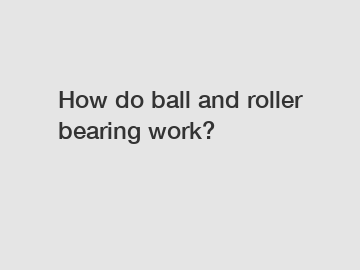How do ball and roller bearing work?
How do ball and roller bearings work?
Ball and roller bearings are essential mechanical components that serve a crucial role in various power transmission applications, from automobiles and aircraft to industrial machinery. These bearings reduce friction and allow smooth rotational or linear movement between moving parts. Understanding how ball and roller bearings work can provide valuable insights into their design and function, which can be particularly useful for those involved in engineering, manufacturing, or maintenance processes.
1. The Concept of Bearings:

Bearings are mechanical components that support the load, carrying it while allowing controlled motion between two moving parts. They function by reducing the friction encountered during relative motion. In the case of ball and roller bearings, rolling elements are used to separate the moving parts, ensuring minimal sliding occurs.
2. Ball Bearings: A Closer Look:
2.1 Construction:
Ball bearings consist of an outer ring, known as the outer race, an inner ring, or inner race, a set of steel balls, and a cage or retainer that holds the balls in place. The outer and inner races have curved surfaces, facilitating smooth motion along with the balls.
2.2 Working Principle:
When rotational or linear force is applied to the outer race, the balls transmit this motion to the inner race, allowing undisturbed rotation. This mechanism significantly reduces friction, as the rolling elements experience less surface contact compared to sliding friction. The cage prevents the balls from colliding with each other and maintains proper spacing for efficient operation.
3. Roller Bearings: A Deeper Insight:
3.1 Construction:
Roller bearings feature cylindrical or tapered rolling elements, which differ from the relatively smaller and rounded balls used in ball bearings. The outer race, inner race, and cage/retainer are similar to ball bearings, but the shape and size of the rolling elements significantly vary.
3.2 Working Principle:
Roller bearings also facilitate smooth rotational or linear motion by utilizing rolling elements instead of sliding friction. The larger contact area of the cylindrical or tapered rollers, compared to the balls, enables them to withstand higher loads. The inner and outer races' curved surfaces guide the rollers, minimizing friction and wear.
Conclusion:
Ball and roller bearings play a vital role in various industries by reducing friction and enabling smooth motion between moving parts. Ball bearings utilize steel balls, while roller bearings employ cylindrical or tapered rollers. Both types minimize sliding friction by incorporating rolling elements, leading to improved efficiency and longevity.
Understanding the working principles of ball and roller bearings is crucial for engineers, manufacturers, and technicians involved in design, production, or maintenance processes. Their accurate selection, installation, and lubrication can enhance equipment performance, reliability, and lifespan.
For any further inquiries, questions, or assistance related to ball and roller bearings, feel free to contact us. Our team of experts is ready to provide guidance and support to meet your specific needs.
Contact us today to explore the world of ball and roller bearings and optimize your mechanical systems!
Are you interested in learning more about drive shaft cross bearing, tensioner bearing function, deep groove ball bearing advantages? Contact us today to secure an expert consultation!

Comments